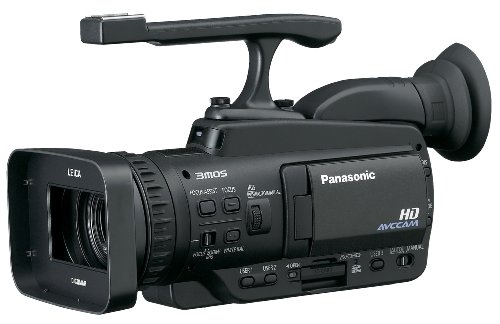
Ah, finally. Been using HDC-TM700 this year to make a professional documentary TV program. Some clients and investors just looked at me using a handycam and asked, "Will you really shoot the TV program using THAT camera?". And I said, yeah, why not? The look on their faces just showed that they don't believe what I say.
So, perhaps they wanted to see me using a bigger camera, but I don't want to use too big camera because sometimes it'll "intimidate" people in my country. By using the word intimidate, I mean that people here tend to look big camera as a television camera, and by pointed at big camera, they ought to think that they'll be in a television. Having that thought will make them run everytime I point my big camera at them.
So I chose the handycam, with a lot of cons I have to bear.
But the wait is finally over. This is the Panasonic Professional AG-HMC40 AVCHD Camcorder.
- Size, the camera is very compact, for a camera that provides broadcast quality image the size is amazingly small.
- Construction, this camera has most of its body made out with metal panels, that makes it very solid and also makes it reliable, also the set up of the buttons are easy to access.
- Tapeless technology, we bought another AVCHD camera a little less than a year ago, we use it mostly for action shots and underwater recording, the transition was effortless, the advantages and capturing time are reduced to minimal and the quality is amazing, with this model we found that its quality is even better than older models and editing is a lot quicker, also recording cost are cut to almost nothing with new SDHC cards that can be used over and over without loosing quality... Just this fact makes it a must buy!!!
- Price, there are other models in the market that could deliver a similar quality or probably a little better but the cost is at least $1k more, if you think like I do "creativity is the main ingredient for a good production", spending the extra cash doesn't really make a difference as long as you are aware of the camera's capabilities and limitations, but there is always ways to improve performance in some conditions that could affect the correct functionality of your equipment.
After using it for this little time I have managed to work around its many controls and get exactly what I want from it, the response to low light is not the best but it's decent, you can always add a good light for little money and resolve that problem, also the sound quality is excellent, I didn't get the optional xlr adapter piece for it but I am using a 8mm wireless mic system that combined with this little fellow deliver great results!!
Here's the pros and cons.
PROS:
1) MPEG-4. Shoots very good quality in a tiny light weight package. Just love it. Even has time-lapse capability which sure beats roto-ing in post for a time lapse effect.
2) You can squeeze two HMC40s in the same size carryon pelican case as the 150.
3) Start editing your shots on Mac in only 2-3 minutes without waiting for rendering. No transcoding required, no $600 P2 cards either. But you should use something faster than just class 6 SDHC media if you want to bump up the quality a little, otherwise you might get some artifacts (image problems) with fast motion and striped clothing. Same problem as any media recording slower than the camera.
4) I'm cool with renting HMC150 and redrock/letus for higher end projects if necessary. This camera is fine for making DVD projects or streaming HD.
5) Great looking shots with 4:2:0 sampling.
6) We produce our own stuff, make a profit and clients keep coming back. With a $1995 retail price tag I can finally afford to own two very nice HD cameras.
CONS:
A) Manual button lovers will need to learn the softkey menus. I love the softkeys with all the same features. No different than using an iphone.
B) Two choices for sound: Seperate sound (best) or get the panasonic/beachtek adapter for on camera. I like using seperate sound on a tascam or fostex digital recorder with four seperate channels (mic 1, mic 2, wild background). This gives you plenty of room to remix in post or replace sounds. Great sound is still 50% of the production.
C) It's not the same glass lens set as 150/170 so you may need different accessories.
D) No timecode jam sync between two cameras. This camera does have its own timecoding (HH:MM:SS:FF). Oh well, I've been living without timecode sync since I started. It just adds a little to the time in post for manually lining up shots and sound tracks. It's no problem to keep using a clapper board anyway. Clappers do give a kinda nostalgic flair for the crew and spectators.
In short words: "the new Panasonic AG-HCM40 is not the best camera money can buy but ,to my opinion, it's the best camera money can buy for this price!!"
Thanks for the info. very helpful
ReplyDelete